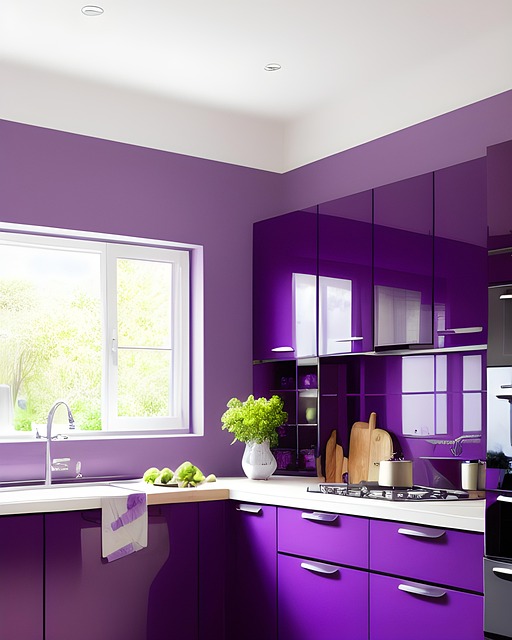An open-concept kitchen design transforms hosting by seamlessly integrating cooking, dining, and living spaces, encouraging guest interaction and enabling hosts to multitask effortlessly from casual get-togethers to grand celebrations. Key elements include efficient cooking zones with separated tasks, strategic seating arrangements fostering conversation, optimized serving areas minimizing clutter, and a vibrant atmosphere extending from the kitchen into adjacent spaces for enhanced guest engagement, making it ideal for both chefs and guests alike.
Create a seamless flow for any gathering with strategically designed spaces. An open-concept kitchen design is the hub of your home, and optimizing it for hosting can elevate your entertaining experience. This article explores how to create dedicated zones for cooking, serving, and mingling, ensuring a smooth dynamic. From efficient cooking stations to cozy seating areas and optimized serving spaces, we’ll guide you through designing a layout that encourages conversation and connection.
Open-Concept Kitchen Design: The Heart of Hosting
An open-concept kitchen design is a game-changer for entertaining and hosting, creating a dynamic space that fosters interaction and connection. By eliminating traditional barriers between cooking, dining, and living areas, this layout invites guests to mingle freely while the host prepares meals. The kitchen becomes the central hub where conversations flow, recipes are shared, and memories are made.
This design philosophy encourages a more relaxed and social atmosphere, breaking down the isolation often associated with separate rooms. Whether it’s a simple gathering or a grand celebration, an open-concept kitchen allows for seamless movement between cooking, serving, and mingling zones, ensuring a smooth flow throughout the event. It’s not just about aesthetics; it’s about creating a functional environment that enhances the overall experience of hosting.
Creating Efficient Cooking Zones
In an open-concept kitchen designed for hosting, efficient cooking zones are paramount to maintain a seamless flow during events or gatherings. The layout should prioritize functionality by separating different culinary tasks into distinct areas. For instance, designate a primary cooking zone with ample counter space and high-performance appliances, ideal for preparing main dishes. Nearby, create a secondary area for prep work, complete with additional storage and cutting boards, to keep the process organized.
Consider incorporating multiple levels or stations to enhance productivity. A raised grill or cooktop can serve as a dedicated space for grilling meats while keeping the main cooking surface clear for other preparations. By structuring the kitchen with these focused zones, hosts can easily manage meal preparation, ensuring guests enjoy a well-organized and enjoyable dining experience.
Designing Seating Areas for Mingling
In an open-concept kitchen for hosting, seating areas should be designed to encourage conversation and interaction while allowing easy access to the culinary hub. Long, shared tables or comfortable couches with ottomans create opportunities for guests to gather and chat. Arrange these seating zones strategically—nearer to the kitchen for those involved in preparation, and slightly farther away for casual conversers. This layout ensures that everyone feels included, even if they have different levels of participation in hosting duties.
Consider using moveable furniture or flexible arrangements to adapt to changing dynamics throughout the evening. For instance, a fold-out table can be used during the initial mingling phase and stored away when more space is needed for dancing or other activities later on. Such adaptability enhances the flow of events, making your open-concept kitchen ideal for hosting memorable gatherings.
Optimizing Serving Spaces
In an open-concept kitchen designed for hosting, optimizing serving spaces is key to ensuring a smooth flow during events. Strategically place serving stations near the kitchen to minimize travel time and reduce clutter. Consider using side tables or rolling carts to display dishes, allowing easy access for both servers and guests. This setup not only keeps the space organized but also encourages mingling by keeping food within reach.
Additionally, ensure that serving areas are well-lit and visually appealing to enhance the overall dining experience. Incorporate adjustable lighting fixtures or decorative lamps to create a warm and inviting ambiance. By thoughtfully arranging these spaces, you can maintain a dynamic yet controlled environment, fostering conversations and creating lasting memories for your guests in your open-concept kitchen.
Streamlining Flow with Strategic Layouts
In the realm of hospitality, creating a seamless flow between cooking, serving, and mingling areas is key to a successful gathering. One effective strategy is adopting an open-concept kitchen for hosting. This design approach eliminates barriers, allowing chefs and servers to move freely while guests enjoy the lively atmosphere. By integrating these zones without walls or with minimal partitioning, you facilitate easier communication and interaction between hosts and their guests.
A well-thought-out layout ensures that the energy generated in the open kitchen spills over into the serving area, fostering a vibrant ambiance. Similarly, designated mingling spaces complement this flow by providing comfortable seating options nearby, encouraging guests to engage in conversations while enjoying the culinary delights prepared in the adjacent kitchen. This strategic arrangement not only streamlines the hosting process but also enhances overall guest experience, making your gathering memorable for all involved.
An open-concept kitchen, designed for efficiency and flow, is the cornerstone of successful hosting. By creating distinct yet interconnected zones for cooking, serving, and mingling, you can optimize space while fostering a vibrant atmosphere. Whether it’s streamlining your kitchen layout or designing cozy seating areas, each element contributes to a seamless experience for both hosts and guests. Embrace these strategies to transform your kitchen into the heart of your home, where memories are made and connections thrive.
